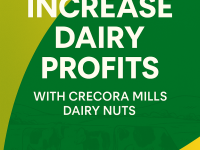Making the Most of Milk Prices: Why Feeding Crecora Mills Dairy Nuts Pays Off
In the next few months, every litre of milk counts. With milk prices under pressure (several co-ops have cut their price per litre recently) Agriland+2Irish Examiner+2, dairy farmers need to look closer than ever at the margins. One of the smartest places to protect margin is in feed — because good feeding pays back in extra litres, better components, improved health, and longevity.
Feeding a premium product like Crecora Mills Dairy Nuts is more than expense — it’s an investment. Here’s how the financials stack up:
1. Increased Milk Yield per Cow
A better energy–protein balance leads to higher milk output. Suppose switching cows (or blending part of the diet) to Dairy Nuts yields even 0.5 to 1.0 L extra per cow per day (a conservative estimate in many well-formulated trials).
-
Over a 150-day lactation window, that’s 75 to 150 extra litres per cow.
-
If milk price is ~ 48 c/L (including bonuses, etc.) (recent quoted rates are around this ballpark) Irish Examiner+2Irish Examiner+2, that’s €36 to €72 extra income per cow from yield alone.
-
On a 100-cow herd, that becomes €3,600 to €7,200 additional revenue in that period.
Even if the real gain is half that, it still gives you a buffer when prices drop.
2. Better Milk Components & Quality Bonuses
Higher quality feed helps push up butterfat and protein, lower somatic cell counts, and fewer milk quality penalties. Many co-ops offer bonuses for low SCC or sustainability/quality payments Agriland+2ICMSA+2.
Improving components by even 0.05–0.10% on a large volume can translate into extra cents per litre. That bonus money helps offset feed cost risk.
3. Health, Fertility & Longevity Savings
Feeding a more consistent, balanced ration reduces metabolic stress, lowers incidence of mastitis, acidosis, and other disorders. Fewer vet bills, less milk discarded, lower culling rates — all of these reduce costs.
Better fertility means cows get back in calf quicker, fewer dry days, and longer productive lives. The net effect is lower replacement costs over the years ScienceDirect+3Teagasc+3researchrepository.universityofgalway.ie+3.
4. Feed Efficiency & Cost per Litre
Premium nuts may cost more per tonne than basic rations, but the cost per litre of milk produced is the real metric. If Dairy Nuts push your feed conversion (kg feed needed per litre) lower, your effective cost per litre falls.
You might be willing to pay, say, €20–30 more per tonne if you end up producing 5–10% more milk per cow — depending on your scale, that extra milk covers the higher feed cost plus something in your pocket.
5. Risk Mitigation in a Falling Milk Price Environment
Milk prices are trending downward in some regions (recent reductions by co-ops) Agriland+1. If you rely on a low-cost, lower-performing diet, a price drop hits you harder. But with a higher-yield, higher-quality herd, your margin cushion is bigger.
In other words: when milk price falls, a high-performing cow offsets more of the revenue shock than a low-producing one.
Sample Financial Illustration (Hypothetical)
| Metric | Base Diet | With Dairy Nuts (Hypothesis) |
|---|---|---|
| Milk yield per cow/day | 25 L | 25.8 L (+0.8 L) |
| Days in lactation measured | 150 | 150 |
| Extra milk per cow | — | 120 L extra |
| Price per litre | €0.48 | €0.48 |
| Extra revenue per cow | — | €57.60 |
| Herd size | 80 cows | 80 cows |
| Total extra revenue | — | €4,608 |
| Extra feed cost (nut premium) | — | €1,200 (approx) |
| Net gain | — | €3,400+ |
This is a simplified illustration; your actual numbers depend on herd size, feed cost differential, and realized yield gains. The point is the upside is significant — enough to make the premium worthwhile.
What To Watch / Manage
-
Monitor feed costs closely and compare to revenue gain.
-
Track milk components & bonuses to see if quality improves.
-
Keep a close eye on health and fertility metrics.
-
Be cautious with overfeeding or imbalance — always feed a balanced ration.
-
Ensure your feeding system keeps consistency — you don’t want waste or mismatch.
Bottom Line
Feeding Crecora Mills Dairy Nuts is not just a cost — it’s a lever to enhance output, push quality, reduce health losses, and better absorb milk price volatility. In an environment where milk price is no longer guaranteed to rise, those extra litres, bonuses, and risk buffers can make the difference between scraping a profit and making real gains.

